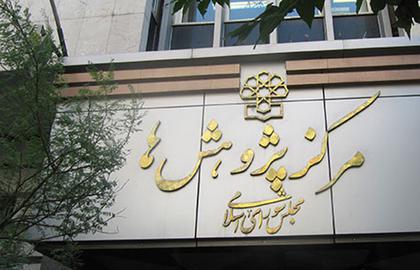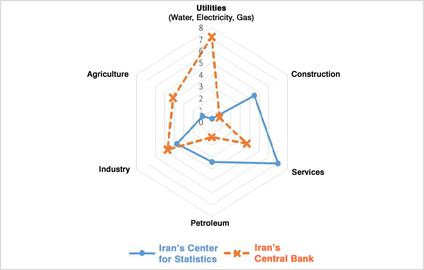Iran’s government continues to suffer setbacks to its financial planning and attempts to overhaul the economy because of inconsistencies in data and “statistical confusion,” according to new research.
A report by Iran’s Parliament Research Center published on April 23 reveals that statistics the government uses to create financial policy fails to give a clear picture of economic growth, making recovery even more challenging.
The report, entitled “The Pathology of Iran’s Statistical System” [Persian PDF], reviews inconsistencies between macro-statistics published by Iran’s Center for Statistics and the country’s Central Bank. Despite government efforts to ensure the data is more reliable, the report says these incompatibilities have not only not been resolved but in certain cases have become worse.
One of the gaps between figures produced by the Center for Statistics and those supplied by the Central Bank is about “national accounting” — statistics that show the rate of economic growth and how it relates specifically to various sectors. This data represents the current levels of supply and demand and provides the most fundamental tools for planning production. Any errors in these figures can lead to economic policies being drafted in a way that is counterproductive to economic growth.
According to the report, despite the fact the two bodies begin their statistical analysis from the same date — adopting the Iranian calendar year 1390, which started on March 21, 2011 as their “base year” — this has not improved the quality of the data, and it has even made the discrepancies between the two sets of figures more pronounced and confusing. Furthermore, inconsistencies cannot be explained by differences in sampling, as they exist even when the statistics are based on officially-recorded numbers.
The Parliament Research Center report focuses on statistics regarding growth in various economic sectors in the first nine months of the Iranian calendar year 1396, from March 21 to December 21, 2017. It concludes that statistics provided by the Center for Statistics and the Central Bank do not provide a clear picture of Iran’s economic growth and that the differences between their numbers are “relatively substantial,” so much so that it would be “very difficult or even baffling for an economist or a statistics expert to accept that these two sets of statistics belong to the same period and to the same country.”
“Astonishing” Incompatibilities
Yosef Gidanian, a director at the Israeli Central Bureau of Statistics (CBS), describes the differences between these two sets of statistics “astonishing.” In particular, he expressed serious doubts about the accuracy of the numbers provided by Iran’s Center for Statistics. He also told IranWire that the sampling methods used by the center were unclear and that the center must explain the methods it uses to come up with such “positive” numbers. He said, too, that it was possible that the Center for Statistics figures were the result of pressure — whether direct or indirect — from government officials. According to him, international organizations have always viewed the statistics published by Iranian government-run centers with skepticism.
Gidanian said the Central Bank’s numbers gave a more accurate picture of the real situation.
Statistics provided by the Central Bank suggest more growth in industry, agriculture and utilities than figures presented by the Center for Statistics. In the case of utilities, the difference between the two sets of data is significant, by close to seven percent. In addition, the Center for Statistics figures show a bigger growth in the construction, services and petroleum sectors. Numbers from the Central Bank put the growth in construction below one percent, while the Center for Statistics has it at 4.5 percent.
The Center for Statistics data shows an 8.3 growth in financial services, while the Central Bank declares the growth in this sector to be 3.2 percent. Figures for real estate, and for specialized and professional services are very different as well. The Center for Statistics declares the growth rate in this sector to have been 7.3 percent but the Central Bank puts the rate at 3.2 percent.
When it comes to data for general services, the two institutions’ figures show a discrepancy of five percent, but the most striking difference lies in the sector for social, personal and household services. According to the Center for Statistics, the growth in this sector was an impressive 9.2 percent, while the Central Bank declares the growth in the sector to have been a negative 4.6 percent.
No Legal Infrastructure
The Parliament Research Center report emphasizes that the “statistical confusion” that endangers Iran’s economic policies has been caused by the fact that there are “two different statistical systems.” So why are there two different institutions collecting data? The report says this is down to a lack of “a legal infrastructure” for gathering statistics. It says existing legislation pertaining to data collection ignores division of labor and accountability, does not provide enforcement measures to ensure reliable figures and information are produced, and sets no standards for the quality of this information. To remedy the situation, the report recommends a two-pronged strategy: looking at Iran’s economic climate in the short-term and long-term.
In the long-term strategy, authorities must pass and enact laws that, among other things, put more responsibility on government institutions to provide facts to organizations charged with gathering and processing statistics. This, the report says, would improve communication between the two sides and would set quantitative and qualitative standards.
In the short-term strategy, the highest executive office — meaning the president — should appoint a committee of experts to study the reasons behind the incompatibilities between the statistics provided by different organizations and recommend solutions.
Yosef Gidanian agrees that the creation of a center for setting laws and standards for the statistics Iran’s policymakers use could reduce inconsistencies and differences. He says that, at the moment, Iran’s Central Bank plays that role to a limited degree, but it is not enough. He points out that developed countries set up these kinds of centers, and they are the sole providers of government statistics. Of course, along with these centers, governments set up independent and supervisory organizations to review and analyze the statistics.
He says that, in addition to gathering correct and reliable statistics, one of the Israeli Central Bureau of Statistics’ responsibilities is to review and supervise statistics provided by Israeli government-run institutions. According to him, in 75 percent of cases, government institutions accept the statistics the organization he works for presents, and they correct their policies based on this information.
Gidanian says that government institutions only question 25 percent of the statistics from the Central Bureau of Statistics. He adds that, although the Israeli government funds part of the budget of this organization, the bureau resists political pressures to manipulate the numbers. If the Iranian government is to ensure its financial planning and policy is robust and fit for purpose, it must put in place impartial and independent institutions to review and supervise the numbers provided by government organizations.

























comments